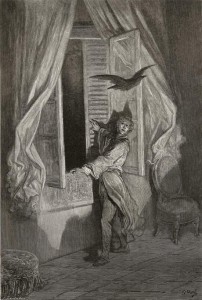Gustave Doré was an amazingly popular illustrator; some say the most popular of all time. He produced more than 10,000 engravings in more than 4,000 editions of literature, travel, and history. In the forty years between 1860 and 1900, a new Doré illustrated version of the Bible, with his 238 engravings, was published every 8 days. Millions of people came to see a gallery of his paintings, along with hundreds of watercolors and dozens of sculptures. His monument to Alexandre Dumas sits in Paris today.
While his name is now unfamiliar to most people, they are not unfamiliar with his work. His engravings have been on the cover of Time magazine, used in such classic movies at King Kong, Great Expectations, and The Ten Commandments, as well as many recent films, like Amistad, Seven, and What Dreams May Come. His Don Quixote drawings have influenced generations of illustrators as well as theatrical and cinema producers.
Doré was born in Strasbourg, Germany, in January of 1832. By the age of 12 he was carving his own lithographic stones and making sets of engravings with stories to go with them. At 15, on vacation with his family, Doré noticed a set of engravings in a publisher’s window. He went back the next day with his own set of drawings and proclaimed his drawings were how the illustrations should be done. The publisher, Charles Philipon, agreed and hired Doré on the spot.
By the time he was 16, Doré was the highest paid illustrator in France. He had published his first book at 15 and become the featured artist in the weekly Journal pour Rire. He produced more than 2,000 satirical caricature engravings before launching into the field of literary engravings in 1854, for Rabelais and Balzac. He produced a giant literary folio of Dante’s Inferno. His publisher refused to publish the book, declaring it too expensive at a hundred francs. Doré paid the bill and in two weeks, the 100 he printed were sold and more were ordered.
Throughout the next 20 years, he illustrated everything from Don Quixote to Baron Munchausen to Perrault’s fairy tales. The Doré Bible was so famous it is mentioned in Twain’s Adventures of Tom Sawyer. He tried his hand at painting with varying success in France, but his art was embraced in England. In 1867 a gallery opened on Bond Street in London, and later his work toured the United States. At the Chicago Art Institute, his exhibit drew more than 16,000 daily. In eight months, 1.5 million people came to see Doré’s work. (The previous record for attendance at any US art museum had been 600,000 for an entire year.)
In the 1870’s, Doré turned to sculpture where he redeemed himself with the French. Then he toured the Alps and Scotland, producing watercolor landscapes. In 1882 he had his only US commission to illustrate The Raven by Edgar Allan Poe.

Illustration for The Raven by E. A. Poe.
Only 51 at his death in 1883, Doré had attempted and excelled at almost every form of art and won over the critics and the people. The Galvin Rare Book Room holds many editions of his work and several are currently on display on the first floor of Boatwright Library through September 2014.
